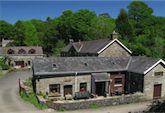The Brown Trout [Salmo trutta], the native trout of Wales, breeds every summer at Plas Farm and can often be seen leaping for insects that fly low over the mountain stream that runs past the holiday cottages. They have returned to the clean river gravels in which they were born to spawn once more and complete the circle of life. Spawning tends to take place in September and October as water temperatures begin to fall for the winter. The female digs a shallow redd into which the eggs are deposited. The eggs take approximately 150 days to hatch, the longest time of any freshwater fish in Wales. The young fish spend at least a year in the natal stream before moving downstream to the sea. The growth of trout is very dependant upon the environment and the trout at Plas Farm rarely grow bigger than eight inches in length and weigh less than a pound. Staying small helps them to avoid predators like the dreaded heron which occasionally makes an appearance in the stream outside the holiday cottages.
The River Clydach
I should perhaps mention at this stage something of the river itself. Its name, the River Clydach, means “a river flowing through a shaded place”. It begins as small springs in the bog depressions high on the flanks of Mynydd Marchywel where many gullies link to form a small stream. It then passes through Plas Farm, and continues to run within the confines of the Dyffryn Trough, the small valley that interconnects the deeper-lying Swansea and Neath valleys. The river ends at its confluence with the River Neath at Neath Abbey, site of a great 12th century Cistercian Abbey famously described by John Leland in the 16th century as “the fairest in all Wales”. The abbey is a great place to visit if you are holidaying at one of our cottages.
The Dingle on the River Clydach in South Wales
European Eel Anguilla anguilla
The only other species of fish that has ever been spotted at the farm is a big European Eel [Anguilla anguilla], which lived for a while in the pool shown above, which we call ‘the dingle’. It certainly gave swimming in the river an extra bit of excitement! At the time, I used to poke it out from under it’s rock with a stick to the amazement of my childhood friends. If I had realised its life story I may have thought twice. For it had travelled far to make its home in this little corner of Wales.
It was born in Sargasso Sea (so named because there is a kind of seaweed which lazily floats over its entire expanse called sargassum) in the Mid Atlantic, somewhere between the West Indies and the Azores. Still only a larvae, and looking a bit like a curled leaf, it hitched a lift on the Gulf Stream and begun a three year journey to the coasts of Europe, drifting slowly amongst the plankton. In the departure lounge of the Gulf Stream, the young larvae underwent metamorphosis and became a young eel, albeit a transparent one (known as a glass eel). It then darkened in colour and found nice freshwater stream to migrate up, just like the one outside our holiday cottages. Now known as an ‘elver’ the young eel measured about 50mm in length. The eel, now called a ‘brown’ or ‘yellow eel’ grew in the freshwater spending between 6-12 years and 9-20 years in the freshwater depending on whether it was a male or female. Towards the end of this time, it became sexually mature; turned a silvery colour and migrated back towards the sea on a dark, moonless and stormy night; during this time they are known as ‘silver eels’. Either that or it became annoyed with a little boy constantly poking him out of his hiding place. Remarkably, it may even have spent several hours traveling overland on one dark rainy night to get back to the sea. Upon returning to the sea, the eel lived in mud, crevices, and under stones hiding from predators, including cormorants and gulls, as well as a number of species of fish. And then it began it’s big journey home – back to its childhood playground in the Sargasso Sea. There it probably found a partner and after a ‘special hug’, more larvae were born. The eel that once spent a long holiday at Plas Farm, may well still be out there in the Mid Atlantic for all I know. With a life expectancy of 85 years it will probably still be there when I am gone too. Sorry old boy. No harm intended.
Did you know that the eel is a ‘catadromous’ species? This means that it is capable of breeding in the sea and migrating to freshwater in order to grow before returning to the sea to spawn.
Our holiday cottages in South Wales are prefectly located to enjoy a fishing holiday. More information can be found on our fishing holiday pages.
